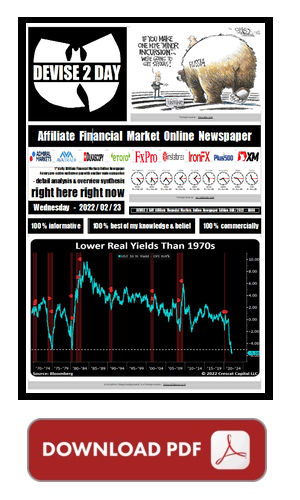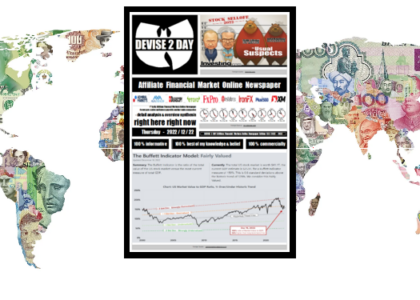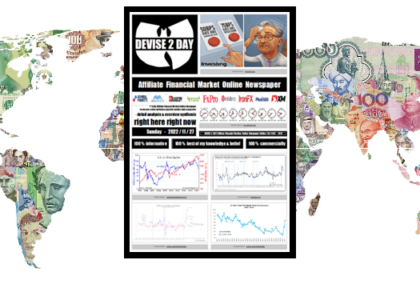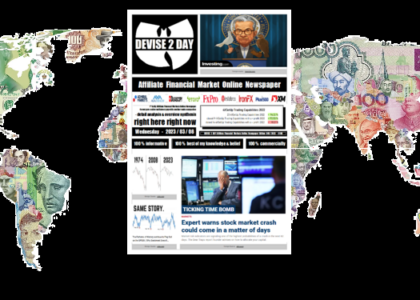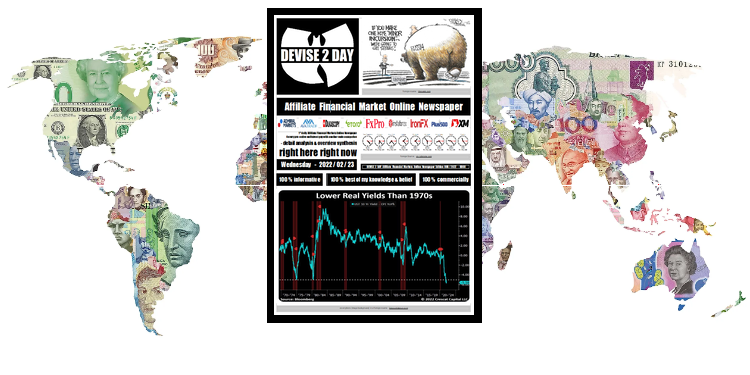
2022/02/23 (008) Column
Worries about Inflation in the west & danger of war from the east,
that`s driving the financial market price action & participants!
Biden has just been us president for a little over a year,
but i miss Trump already! Not you too?
US Stocks Sink, Dow Ends at 11-Month Low
Wall Street went into a tailspin on Wednesday, with investors nervous about the Ukraine crisis and the consequences of Western sanctions against Russia on growth and inflation. After an initial round of sanctions on Moscow, US President Biden announced new penalties hitting the builder of the Nord Stream 2 gas pipeline. US intelligence warned Ukraine of full-scale Russian invasion within 48 hours while several countries including the EU, the UK, Canada, Australia and Japan also imposed restrictions on Russian companies, individuals and financial markets. Meanwhile, Ukraine’s parliament approved a declaration of a state of emergency in the entire country and told its citizens in Russia to immediately come home, while Moscow began evacuating its Kyiv embassy. The Dow Jones lost more than 460 points to close at its lowest level in about 11 months; the S&P 500 declined 1.8%, extending losses for the 4th day and falling deeper into correction territory; and the heavyweight Nasdaq shed 2.6%.
Russian Ruble Remains Near 15-Month Low
The Russian ruble was trading around 80 per USD, the weakest in 15 months as investors were digesting a round of sanctions announced by Western leaders in response to the deployment of Russian troops in self-proclaimed Donetsk and Luhansk republics in eastern Ukraine. The US took measures against banks and prohibited participation on the secondarymarket for Russian sovereign debt, while Germany halted the certification of the Nord Stream 2 pipeline. Harsher sanctions could also be imposed should Russian forces move further west from the Donbass. Meanwhile, the Central Bank of Russia remains unsure of when to resume foreign exchange purchases due to the ruble’s increased volatility. On its February 11th meeting, the CBR hiked its benchmark rate by 100bps to a five-year high of 9.5%, as widely expected, while signalling further hikes could take place in the next meetings.
Hong Kong Dollar Hits 26-month Low
The Hong Kong dollar declined to as low as 7.8040 per greenback, a level not seen in over two years and passing the midpoint of its 7.75 to 7.85 allowed trading range against the US currency as escalating tensions between the West and Russia over Ukraine hurt the appetite for risk assets.
China’s Yuan Hits Near 4-Year High
The offshore yuan strengthened to 6.308 per USD, the strongest level since April 2018, as the escalation of tensions between Russia and the West boosted foreign demand for the Chinese currency. The latest Western sanctions against Russia’s financial sector have helped accelerate a trend which saw Russian institutions diversify away from the greenback, into the yuan, among other currencies. Harsher sanctions on the table include complete restrictions on USD transactions by Russian firms, which would further boost demand for the yuan over the long-run, risking efforts by the People’s Bank of China to keep the yuan steady and protect exports. Recently, the PBOC pumped more liquidity into the financial system and slashed several policy loan rates, with analysts saying policymakers have more room for expansionary monetary policy.
Aussie Hits 5-Week HighThe Australian dollar briefly hit an over five-week high of $0.7277 before steadying above $0.727 on Wednesday, as robust commodity prices supported the currency. Markets also took stock of Western sanctions imposed on Russia after Moscow ordered troops into two separatist regions of Ukraine. Meanwhile, Australian wages grew 2.3% on an annual basis in the December quarter, missing expectations and falling short of the 3%-plus levels that policymakers said would justify a rise in interest rates. The data added to growing uncertainty for the direction of monetary policy as markets have long been pricing in a hike in the 0.1% cash rate by June, with rates reaching 1.25% by year-end. Minutes of the RBA’s latest meeting also showed its Board was yet to be convinced that the acceleration in inflation would be sustained and wanted to see wages respond before lifting rates.
good morning, good day, and/or good night
at whatever time, wherever you are !
right here right now :

